Phone
03 8580 2441
Reception: reception@zenithmedicalcentre.com.au
Address
58 Robinson Street,
Dandenong 3175
Many authorities have frowned at Infusion treatments of nutrients including and EDTA treatments based on lack of evidence. It looks as if we collectively forgot the truism that lack of evidence of efficacy is not the same as evidence of lack of efficacy. The bone of contention has always been on the efficacy of the treatments offered by Functional Medicine practitioners. As a person not naive to research, I can understand the positions of the skeptics. A privately funded service like Functional Medicine, can not have enough materials to prove efficacy: recruit enough patients and meet a perfectly designed powered research paper and get the patients randomized; get the laboratory blood and imaging report to prove efficacy.
Despite this, at Zenith Medical Centre, our infusion clinic is not a boutique infusion salon where someone can just drop in a get fitted with a drip. We offered personalized Infusion drips of nutrients, Iron and when indicated EDTA for patients with peripheral arterial disease especially those with complicated diabetes.
There are evidence, though sample sizes are not as big, that the infusion of nutrients make a difference in patient care.
We offer "Myers’ Cocktail", IV NAD+ for Mitochondrial Support and Addictive Disorders, Vitamin C push, EDTA infusion.
If you want to know more about our infusion clinic, please call the practice for initial general booking.
You will be advised of our protocols and the cost involved.
See below some of the nutrients and supplements available to support you in your journey to wellness, happiness and health.
Please read on......
Iron infusion
Iron is essential for the transport of oxygen from our lungs to the body tissues. Without enough iron, our body cannot produce enough of haemoglobin in red blood cells that enables them to carry oxygen.
As a result, iron deficiency anaemia may leave you with tiredness and shortness of breath.
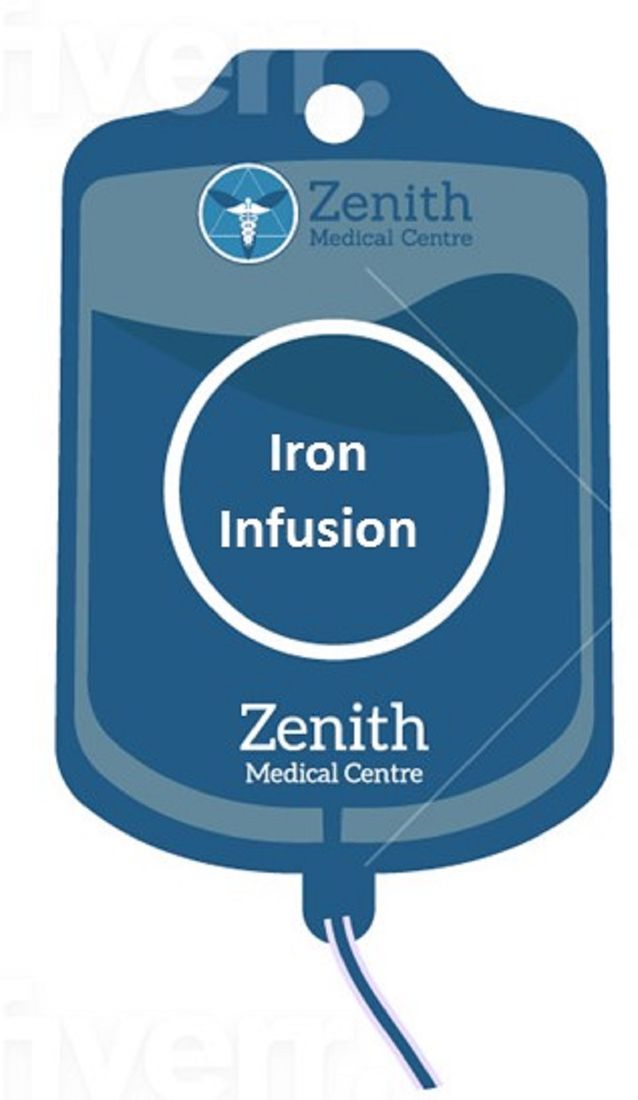 |
While there are numerous causes for iron deficiency, the common ones include:
Intravenous iron infusion if administered appropriately can be an excellent option for those suffering from
There has been reports of side effects. These may include
Severe side effects are very rare but be sure, we are there to look after you.
Benefits:
An iron infusion is a way to increase the body’s iron levels quickly.
May be all you need to overcome that fatigue is iron. Speak to us today for an assessment to see if iron infusion may be appropriate for you.
Come in and have a check-up and our doctors will give you professional advice.
Reference
Glutathione
Glutathione (GSH) is an antioxidant often called ‘the master molecule’, and for good reason. This powerful antioxidant plays a role in many different systems in your body from immune support to anti-aging and more. Since Glutathione is not typically absorbed well by our body, IV Gutathione is an ideal way of incorporating this versatile antioxidant into your wellness routine.
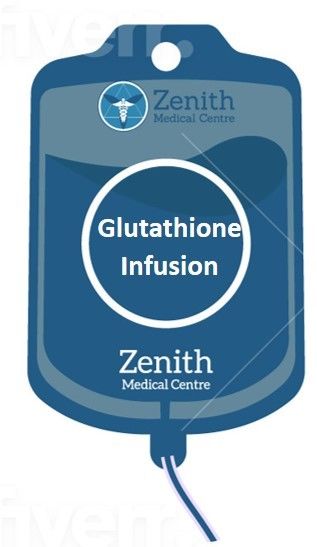 |
Glutathione infusion especially when in combination with other vital supplements is capable of preventing damages to important components of our cells. There are compounds called reactive oxygen species such as free radicals, peroxides, lipid peroxides, and heavy metals. These chemicals are produced as we grow generate energy from the food we eat.
Free radicals can cause DNA damage, impairing cellular function or killing cells altogether. Damaged cells open the doorway to potential disease and illness. That’s where antioxidants come in.
Even if you are not sick, Glutathione is good for you. IV glutathione is ideal for athletes. Glutathione works to improve your beauty from the inside out, so the end result is glowing, radiant skin and healthy hair and nails.
This antioxidant helps improve your energy levels, which are low when you’re under the weather, so you can feel better equipped to tackle whatever your day has in store for you.
The truth is; this nutrient works from cellular level and so it takes some sessions for optimal response. Evidence abound on the positive effect this powerful antioxidant infusion can make in getting your life back.
Reference
Vitamin C infusion
Vitamin C infusion is quite different from taking Vitamin C orally. No matter how many oral tablets taken daily, the body only absorbs little (in some cases less than 50%).
Due to some positive findings in many recent studies, this old nutrient Vitamin C is now gaining new interest among scientists. The positive findings reported so far are not from the oral form of Vitamin C but when given in a drip.
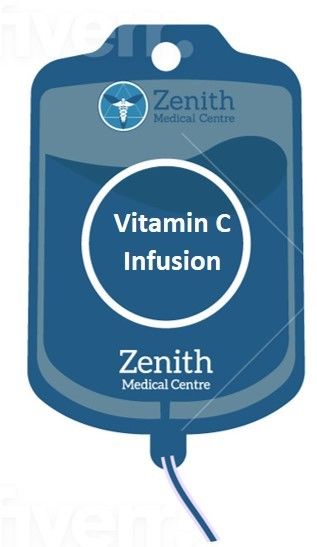 |
When given in a drip, Vitamin C produced plasma concentrations that are much higher than those from oral intake.
This blood levels are not possible from oral intake and researchers believed this is what is responsible for the positive reports. This is why it is very important which route of administration is used.
As humans, every cell in our body generates reactive oxygen species (ROS). Vitamin C helps the cells to clear these ROS.
Vitamin C depletion might occur more readily in patients with cancer because of lack of or reduced oral intake, decreased bioavailability, increased tissue utilization, and increased oxidative stress (excess ROS))
These ROS have multiple downstream targets, including but not limited to DNA damage, mitochondrial damage, and stimulation of cell death pathways.
Side Effects/Risks of High-Dose Vitamin C
Generally intravenous high-dose ascorbic acid has caused very few side effects in clinical trials. However, high-dose vitamin C may be harmful in patients with certain risk factors.
Is Vitamin C IV Therapy Right for You? Come in and check out. At Zenith Medical Centre, we find out though thorough assessment to weigh with you the benefits versus the potential risk.
Benefits
Although it sound very reasonable to understand the extensive benefits of IV Vitamin C infusions, selection of patients is very important.
Reference
NA2EDTA Infusion
What is EDTA? EDTA is Ethylene-Diamine-Tetra Acetic acid! Jaw breaking to pronounce? You are right. It is a transparent, water-soluble compound first synthesized in 1935. It belongs to a class of molecules called chelators. Chelators are chemicals that binds metal ions.
EDTA binds minerals and it is especially attracted to those with a +2 or +3 charge. EDTA removes toxic heavy metals such as lead, cadmium, and chromium. It also remove trace elements like Aluminium, and also essential minerals such as calcium, magnesium, copper, and zinc.
Why then do we use such ‘greedy’ stuff as infusion? Good question, we will come back to this after some background information.
How does Plaque forms in our blood vessels? It a million dollar question. The answer from some doctors may be; it is due to high cholesterol, some will say, it is obesity, diabetes, genetics or bad diet. The diet–cholesterol–heart hypothesis has been dominant during the past 60 years.
The truth is; it is multifactorial; but one thing is clear from all these previous responses; the environmental poisoning which we are all exposed to from our industrialization have not been looked at; at all. Right from the time a child is born in the maternity till he gives his last breath, we are covered with environmental pollutants.
At the beginning of 20th century, heart disease was an uncommon cause of death-see reference below (Dalen JE et al). It rose rapidly till 1960 and have remained as number-1 killer till date. Why? Answer: Though the cause is multifactorial; but the significant seepage of heavy metals and persistent organic pollutants into our food webs is one critical elements most people have not given serious attention to. These pollutants find their ways into us (i.e into our blood vessels and tissues) through food, water, clothing (soap detergents etc) and the air we breathe.
By these pollutants, I am referring to heavy metals like Lead, Cadmium, Aluminium, Mercury, Arsenic, Nickel, Cobalt and Vanadium-just to mention a few. Other organic pollutants of concern include Bisphenol A (BPA), Insecticides, Tobacco, Vinyl Chloride, Polychlorinated biphenyls (PCBs), Benzene, Alcohol just to mention a few. All these; apart from the drug induced nutritional deficiencies (DINDs) and the misuse of antibiotics are the triggers of abnormal chemistry that lay the foundation on which abnormal changes occur in our blood vessels.
What has all the above got to do with our health and atherosclerosis in particular? Answer: these chemicals above are carcinogen (agents that may cause cancer), teratogens (substance which can cause physical defects in a developing embryo), mutagens (agents that induces genetic changes in our DNA), neurotoxicant (substances that can cause an adverse effect on the chemistry, structure or function of the nervous system) and hormone disruptors (chemicals that may interfere with the body’s endocrine (hormonal) system and produce adverse developmental, reproductive, neurological, and immune effects). No wonder, there is increase in the number of many uncommon medical conditions nowadays which were not common in the 19th Century.
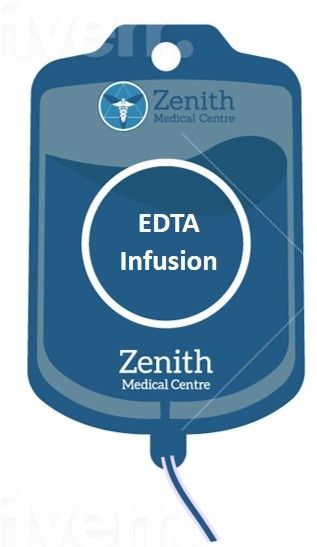 |
What does EDTA do?
Now let’s come back to EDTA. When these heavy metals enters our system, they initiate what we called oxidative chemical reactions in every system of the body via the blood vessels. In the blood vessels, they initiate the process of atherosclerosis when coupled with other favourable factors like environmental pollutants, stress, vulnerable genes, high GI foods and bad diet.
Atherosclerosis refers to the build-up of unhealthy fats, oxidized cholesterol, foam cells and other substances in your artery walls. This is what is referred to as plaques. If left unchecked, over time, this plaques increase in size, length and can restrict or block blood flow especially in small vessels.
The plaque can also burst, leading to a cascade of events that can cause a blood clot and reduction/blockade of the vessels causing death to tissue it supplies (stroke- if it is in the brain, heart attack if it is in the heart muscles).
EDTA, works by removing toxic heavy metals such as lead, cadmium, and chromium, trace elements like Aluminium. It also removes essential minerals such as calcium, magnesium, copper, and zinc. This is why a patient coming for EDTA infusion must be carefully selected and prepared by us.
Although atherosclerosis is often considered a heart problem, it is actually a disease of every vessels in the body.
Critics of chelation often speaks of EDTA taking out Calcium from the blood vessel wall. This is a demonstration of the complete lack of understanding of the mechanism of action of EDTA.
Benefits of EDTA
Anecdotal reports are very clear about its positive effects. These effects ranges from restoration of perfusion in gangrenous diabetic foot to restoration of other vital organs. Also pooled analysis from Cochrane library yielded results of over 70 studies showed positive results in all but one.
Preparation
A candidate for chelation therapy must initially have had a thorough history and physical examination to define the type and extent of the clinical problems. We perform convectional and sometimes expanded laboratory tests to determine whether there are any conditions present that would prevent the use of chelation.
Patients who have pre-existing hypocalcaemia (low blood free calcium), poor liver or kidney function, congestive heart failure, hypoglycaemia (low blood sugar), chronic infection, clotting problems, or potentially allergic conditions are at higher risk for complications from chelation therapy. They may still benefit depending on the individual assessment.
Through our vital scan, coupled with Doppler ultrasound we determine the adequacy of blood flow in different regions of the body before Chelation is offered.
Side effects
Side effects of chelation therapy are reportedly unusual, but are rarely serious. Mild reactions may include, but are not limited to,
Our present regimes are safe with no serious side effects or complications. As can be inferred from above, Chelation is not a standalone treatment, it is part of a well-designed personalised program.
EDTA chelation is still highly controversial therapy among conventional physicians when it comes to treatment of cardiovascular diseases. Notwithstanding this scepticism, this same treatment is approved for lead poisoning and seriously high calcium levels.
Please read the references below and you be the judge to decide if EDTA chelation infusion is something you will like to consider.
References
NAD infusion
Nicotinamide adenine dinucleotide (NAD+) is an essential cofactor in all living cells that is involved in fundamental biological processes. NAD+ depletion has been associated with hallmarks of aging and may underlie a wide-range of age-related diseases, such as metabolic disorders, cancer and neurodegenerative diseases.
Did you know NAD levels greatly diminish as we get older? By age 50, we have 40% less NAD+ than at age 20 and by age 80, NAD+ levels drop as much as 98%. This is one reason why we begin to feel the effects of aging and become more prone to age-related illnesses as the years pass by. One of the ways you can supplement NAD+ in your body is through IV therapy. This is an all-natural way to help your body fight against aging and illness to feel healthier and more youthful.
Speak to us today for an assessment to see if this infusion may be appropriate for you.
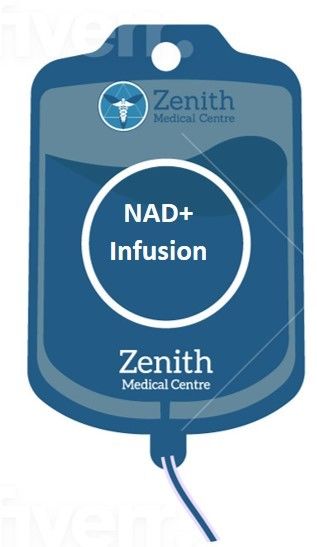 |
Reference
Phosphatidylcholine
Did you know that our cell membrane is made of up over 60% of phospholipids and cholesterol? Phosphatidylcholine (PC) is a major phospholipid in our cell membrane and its subunits. It provides integrity and structure to the all-important membranes and regulates their fluidity. PC also provides structure to circulating lipids and is essential for lipid transport and metabolism.
Because of its ubiquitous nature, it has found applications in supporting many medical conditions because- healthy cell membrane equal healthy body. When the membrane is healthy, it improves cell signalling and neurotransmitter synthesis.
There are different kinds of Phosphatidylcholines (PC) in the markets. There are PCs that contain saturated fatty acid chains, and this will have a detrimental effect on cell membranes and blood vessel walls. And there are other PCs that contain one saturated and one unsaturated fatty acid chain, which is not a beneficial form of PC either. Only the PCs with unsaturated fatty acid chains (linoleic acid) has the proven clinical benefits as described below. This PC are polyenylphosphatidylcholine PEPC or dilinoleoylphosphatidylcholine, DLPC.
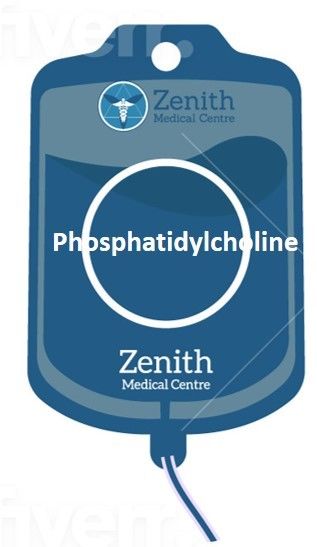 |
The preparation we sourced are helpful in lowering cholesterol levels, triglyceride levels and to improve liver function but also as an additional treatment to its infusions to prevent re-formation of plaque in the blood vessels after removal.
This product is available in oral capsules and also as infusions. At Zenith Medical Centre, we do not give PC as standalone but given as part of a comprehensive plan following a clinical assessment. As good as PC is, it is not good for everyone. Proper assessment is required before this infusion.
You want to know more about this and many more, book for your initial appointment.
Reference
Alpha Lipoic acid
Alpha-lipoic acid (ALA) is an antioxidant normally made by the body. It is found in the mitochondria of every cell, where it helps to generate energy. The role of antioxidants is to attack "free radicals," which are generated in the process of energy production.
Free radicals cause harmful chemical reactions that can damage cells, making it harder for the body to fight off infections. Free radicals also damage cells and by extension our tissues.
Unlike other antioxidant which works only in water (e.g. Vitamin C) alpha-lipoic acid works both in fat and water soluble part of our tissues. That means it can work throughout the body.
Antioxidants in the body are used up as they attack free radicals. But evidence suggests alpha-lipoic acid may help regenerate these other antioxidants and make them active again.
Alpha-lipoic acid is also sometimes called lipoic acid for short. ALA is
found to be very helpful in diabetics, dementia, cancer support and a host of other neurodegenerative diseases. It is available in oral forms, injectable and in infusion.
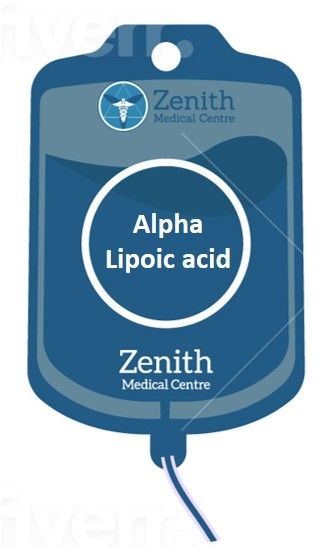 |
Functions of ALA
Alpha lipoic acid (ALA) carries out highly beneficial functions in the human body:
Many popular anti-ageing injections focus on specific areas of the body only, whereas the ALA IV is into the bloodstream intravenously, which benefits skin across the entire body.
It’s Role as Cancer Treatment Adjunct
Preparation of the IV ALA is important as alpha lipoic acid is destroyed by light so it is delivered with protection of the IV bag from light exposure. The most severe reaction patients experienced is a feeling of nausea following the treatment. This clear in a short time after the therapy. In fact, IV ALA is often used to reduce the side effects of other cancer treatments.
Neurotoxicity: Although chemotherapy is a life-saving form of treatment, a common side effect is neurotoxicity leading to peripheral neuropathy. A neuropathy gives rise to a set of symptoms from damage to the nerves controlling how our arms and legs feel and move. Typically, peripheral neuropathies stop once chemotherapy treatment has finished and neurotoxicity is reduced, but the symptoms may also last for years. However, IV ALA can be used to reduce the neuropathic pain as a side effect of chemotherapy drugs (Gedlicka et al. 2002 & Melli et al. 2008).
Diarrhoea: is another common side effect of chemotherapy – in fact, up to 50-80% of treated patients will experience this symptom because of therapy. Chemotherapy drugs like methotrexate often induce intestinal toxicity due to oxidative stress and DNA damage leading to intestinal cell toxicity. As such, using ALA prior to chemotherapy helps protect against intestinal toxicity and improve the consistency of stool.
Cardiac Toxicity: A lesser known side effect of chemotherapy drugs is cardiac toxicity. Cardiotoxicity is typically rare, yet may occur in more than 20% of patients treated with doxorubicin, daunorubicin or fluorouracil (Pai VB, Nahata MC, 2000). They described the following cardiac events that may occur as a result of such chemotherapy drugs: mild blood pressure changes, thrombosis, electrocardiographic changes, arrhythmias, myocarditis, pericarditis, myocardial infarction, cardiomyopathy, cardiac failure (left ventricular failure) and congestive heart failure. ALA does not only ameliorates these symptoms but is also protective against the onset of cardiotoxicity.
Generally this infusion is not given alone but as part of a comprehensive plan after clinical assessment. Speak to us today to see what option there are to support you in your journey to recover your health.
Reference
Myers cocktails
This infusion is compounded based on the foundational work of the late Dr John Myers M.D., a physician at Johns Hopkins University who created the famous “Myers’ Cocktail” in the 1970's. He created the famous “Myers’ Cocktail” which originally consisted of magnesium, calcium, B vitamins, and vitamin C. This intravenous vitamin and mineral formula has been utilized as a safe and effective treatment by hundreds of practitioners to successfully treat a wide range of clinical conditions.
This cocktails can be modified to suit the need of the patient. Through regular review, we have found that our proprietary blend of Magnesium, Calcium, Vitamin B1, Vitamin B5, Vitamin B6, Vitamin B12, Folic Acid and Vitamin C is helpful in migraines, fatigue (including chronic fatigue syndrome), fibromyalgia, acute muscle spasm, colds/flu and other upper respiratory tract infections, chronic sinusitis, seasonal allergic rhinitis and support to improve cardiovascular health.
People who feel run down, "stressed out" and fatigued may benefit tremendously from Myers’ Cocktail and IV nutrient therapy is a great way to keep your system strong throughout the cold and flu season. Many patients report that they feel completely rejuvenated after a single treatment, and the results can last from several days to several weeks.
How is it administered?
It is administered intravenously with a small butterfly needle over about a 30-minute period while the patient relaxes comfortably in a recliner chair. Our Myers’ Cocktail Infusion treatments are commonly ordered once a week for three weeks but can be administered as often as twice per week or as infrequently as once every 3-4 months depending on need.
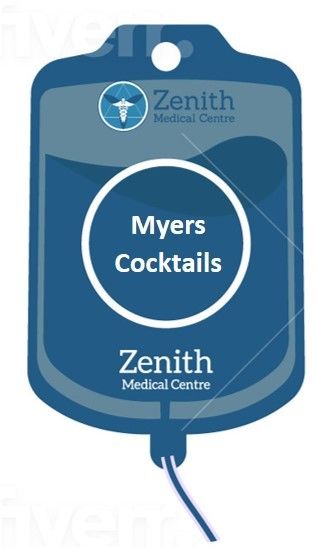 |
How does the "Myers' Cocktail” give me a Boost?
Direct administration of nutrients into the bloodstream bypasses the barrier and limitations of our digestive tract. Intravenous administration of vitamins and minerals can achieve serum or blood concentrations that are just not obtainable with oral or even intramuscular (IM), administration. When optimal serum concentrations have been achieved, various nutrients have been shown to exert pharmacological effects. Some experts believe that in addition to having direct pharmacological effects, IV nutrient therapy may be more effective than oral or IM treatment for correcting intracellular nutrient deficits. This theory is based on the fact that some nutrients are present at much higher concentrations in the cells than in the serum and by “bathing” these cells in high concentrations of nutrients it allows ailing cells to take up nutrients against a smaller concentration gradient.
Are there any Adverse Effects to the "Myers' Cocktail”?
From all available data, “Myers’ Cocktail” infusions are with no serious adverse effects. As with any IV treatment, a patient may have discomfort at the infusion site, light-headedness or vasovagal reaction (fainting). All these symptoms are transient. Intravenous administration of magnesium can function as a vasodilator and muscle relaxer so some patients experience a warming or “flushing” sensation in the face, chest or pelvic area and a feeling of relaxation. Magnesium can also lower blood pressure so there is always the slight chance of hypotension (low blood pressure) but this is seldom, if ever seen in our office, we are experienced enough to adjust the dosage and rate of infusion. In many instances, this treatment is more effective and better tolerated than many conventional medical therapies.
Talk to our doctors and we will find a tailor made solution for you at Zenith Medical Centre.
Reference